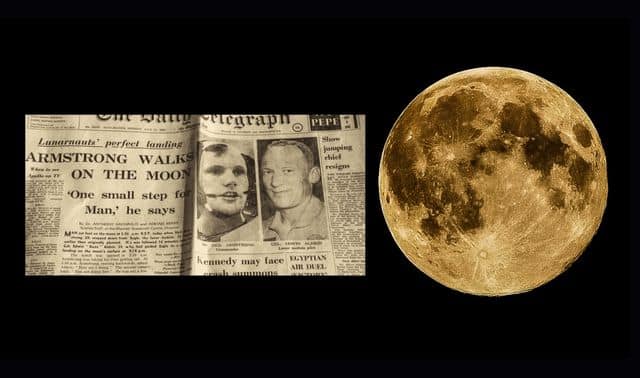Sign up for the Family Tree Newsletter Plus, you’ll receive our 10 Essential Genealogy Research Forms PDF as a special thank you!
Get Your Free Genealogy Forms
"*" indicates required fields
Almost as long as humans could dream or draw, the Moon has captured our imagination. A 5,000-year-old rock carving in Ireland depicts the Moon, and the Ancient Greeks envisioned a trip to the Moon as early as the second century A.D. But we’ve come a long way from just imagining Moon travel; astronaut Alan Shepard hit the first golf ball on the Moon in 1971. Here is a brief timeline of the moon, highlighting our centuries-long curiosity with it.
450 B.C.: The Greeks make early astronomical discoveries related to the Moon
Anaxagoras, a Greek philosopher, theorizes that the Moon doesn’t shine with its own light, but rather with light reflected from the sun. Later Greeks realize the Moon is much closer to the Earth than the Earth is to the Sun, and that the Moon causes the Earth’s tides.
1546: The Proverbs of John Heywood introduces the phrase “the Moon is made of a greene cheese.”
The saying—referring to young, unripe cheese (not literally green cheese)—has its origins in a widely told folk story: A simpleton sees the Moon reflected in water and mistakes it for a wheel of cheese. Similar tales, often featuring animals instead of a peasant, are told by the Zulus, Scots, Gascons, Turks and Serbs. By the 17th century, “the Moon is made of green cheese” is one of the most popular English proverbs.
1835: The Sun (a newspaper in New York City) publishes the “Great Moon Hoax”
Inspired by the fantasy that “lunarians” built a sophisticated civilization on the Moon, the newspaper runs a six-part series announcing the discovery of lunar life. The series describes the Moon as populated by unicorns, two-legged beavers and bat-like humanoids. The articles thrill readers and supposedly boosts circulation, which doesn’t suffer even after the Sun reveals it was all a hoax.
1837: Wilhelm Beer and Johann Heinrich Mädler publish Der Mond
The book is the first trigonometrically accurate study of lunar features. It, along with their Mappa Selenographica, establishes the heights of more than a thousand mountains on the Moon. Their work built on 17th-century telescopic mapping of the Moon, leading to the system of naming lunar features still in use today.
1842: England passes a Lunacy Act
The act enshrines in law the myth linking a full moon with insanity. It distinguishes “normal” behavior from that occurring in the period following a full moon.
1865: Jules Verne publishes From the Earth to the Moon
Verne’s highly technical description of a three-man crew launching in a projectile (from a cannon) to the Moon accurately predicts some aspects of the Apollo 11 mission more than a century later: the crew and craft size, a launch point in Florida, and return by parachuting into the ocean. A sequel titled Around the Moon, follows in 1870.
1901: H.G. Wells publishes The First Men in the Moon in book form
Originally a series in The Strand Magazine, the story follows a businessman and an eccentric scientist to the Moon, where they discover a civilization of insect-like creatures.
1902: A Trip to the Moon becomes the first science fiction movie
Borrowing from both Verne and Wells, French director Georges Méliès’ whimsical film cost a then-astronomical 10,000 francs. His image of the capsule crashing into the eye of the Man in the Moon is an icon of cinematic history.
1941: The Wolf Man movie links full moons and werewolves
The myth of a “wolf man” goes back to the epic of Gilgamesh (circa 2100 B.C.). But The Wolf Man introduces the fake legend that, “Even a man who is pure in heart, and says his prayers by night; May become a wolf when the wolfbane blooms and the autumn moon is bright.”
1959: Soviet space probe Luna 2 crashes into the Moon
Earthlings make first contact with the moon! The next year, Luna 3 snaps the first pictures of the “dark” side of the Moon, and Luna 9 becomes the first object to make a soft landing on the Moon in 1966. But the United States, despite a late start, ultimately wins the “Space Race”: Apollo 11’s lunar module, the Eagle, lands on July 20, 1969. The next day, astronaut Neil Armstrong becomes the first human to set foot on the Moon.
A version of this article appeared in the October/November 2019 issue of Family Tree Magazine.
FamilyTreeMagazine.com is a participant in the Amazon Associates Program, an affiliate advertising program. It provides a means for this site to earn advertising fees, by advertising and linking to Amazon and affiliated websites.
Related Reads
ADVERTISEMENT







